Renault MEGANE 2006 Owner Manual

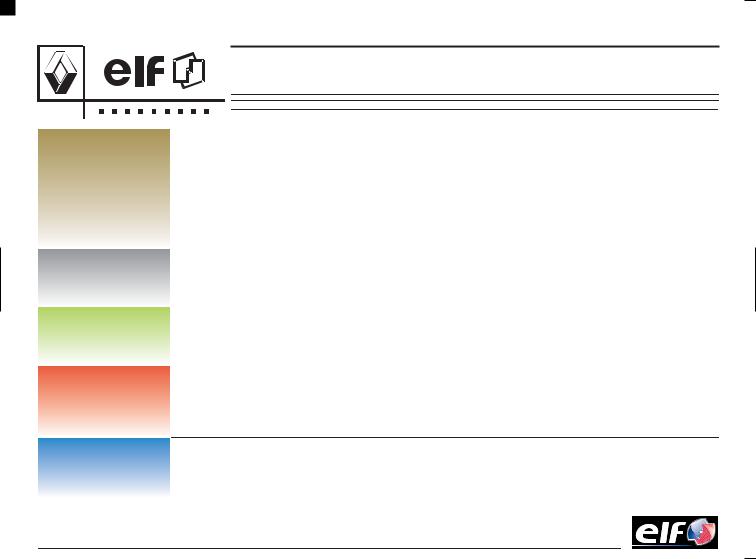



 has chosen ELF
has chosen ELF
Engines of all types except 1.9 dCi with particle filter
1.9 dCi engines with particle filter
Petrol and LPG engines except 2.0T 16V Renault Sport
Engine all types except 2.0T 16V Renault Sport and 1.9 dCi with a particle filter
Gearbox
ELF EXCELLIUM LDX 5W-40 |
ACEA A3 / B4 |
Optimum performance and maximum protection in the most severe conditions |
|
All types of driving |
|
|
|
ELF EVOLUTION SXR 5W-40 |
ACEA A3 / B4 |
Optimum performance |
|
All types of driving |
|
|
|
ELF SOLARIS RNX 5W-30 |
ACEA C3 |
Optimum performance, particle filter protection and respect for the environment |
|
All types of driving |
|
|
|
ELF EVOLUTION SXR 5W-30 |
ACEA A5 / B5 |
Fuel economy, engine protection and respect for the environment. |
|
All types of driving |
|
|
|
ELF COMPETITION ST 10W-40 |
ACEA A3 / B4 |
ELF TURBO DIESEL 10W-40 |
ACEA B3 / B4 |
Other RENAULT approved lubricants for normal use. |
|
Elf has developed specific lubricants for each Renault transmission:
Tranself TRJ 75W80, Tranself TRT 75W80, Tranself TRP 75W80, Tranself TRX 75W80 for manual gearboxes, Renaultmatic D3Syn and Renaultmatic D2 for automatic transmissions.
These fluids are actively involved in the operation of your vehicle. (*)
RENAULT recommends using approved ELF products when topping up or changing the oil.
(*) Refer to your vehicle's Warranty and Services booklet for information regarding which grade of oil to use. Consult your RENAULT Dealer or visit www.lubricants.elf.com
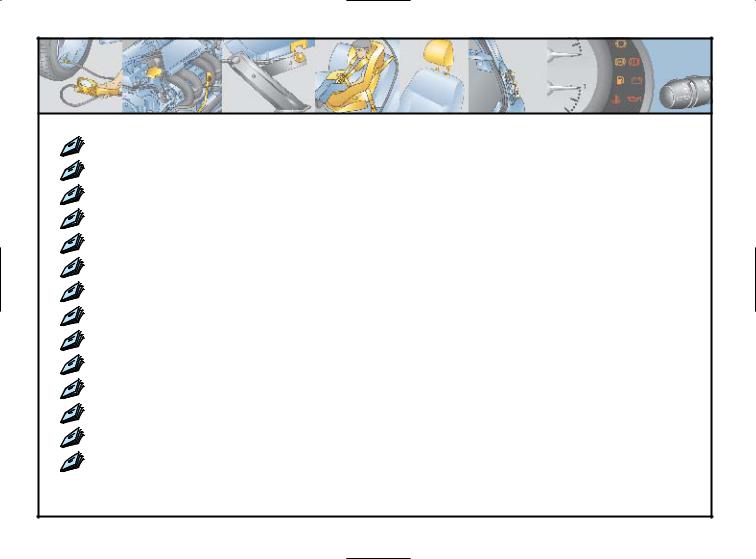
Brief overview
• Tyre pressures ....................................................................................................................... |
0.04 - 0.07 |
• RENAULT card: use .......................................................................................................... |
1.02 1.08 |
• Child restraints/seats ....................................................................................................... |
1.32 1.42 |
• Warning lights (instrument panel) .............................................................................. |
1.46 1.77 |
• Engine Stop/Start ............................................................................................................................. |
2.05 |
• Driving .................................................................................................................................................. |
2.37 |
Tyre pressure monitor ................................................................................................. |
2.15 2.18 |
Electronic Stability Program: ESP ......................................................................................... |
2.19 |
Traction control: ASR ..................................................................................................... |
2.20 - 2.21 |
Emergency brake assist .............................................................................................................. |
2.24 |
Cruise control/Speed limiter .................................................................................... |
2.25 2.31 |
• Heating/air conditioning ................................................................................................ |
3.02 3.16 |
• Bonnet/maintenance ........................................................................................................ |
4.02 4.14 |
• Practical advice (changing bulbs, |
|
fuses, breakdown, faults) ................................................................................................ |
5.02 5.37 |
0.02
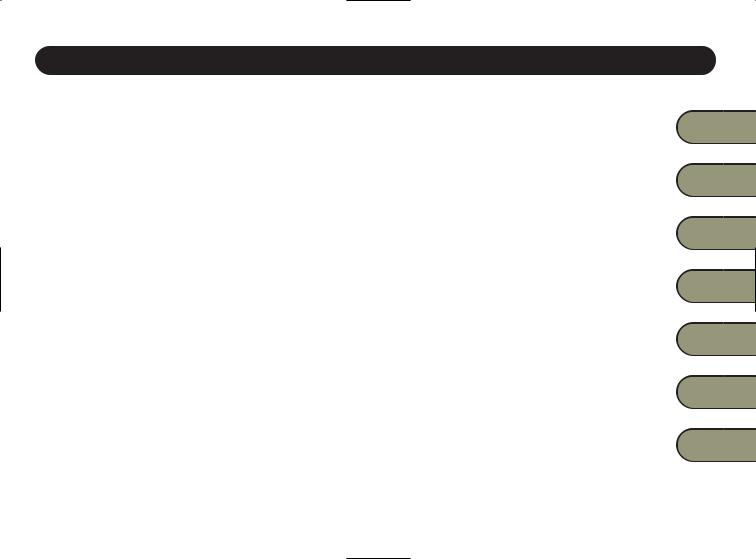
C O N T E |
N T S |
|
Sections |
Getting to know your vehicle |
.................................................. 1 |
Driving .................................................................................................. |
2 |
Your comfort ..................................................................................... |
3 |
Maintenance ...................................................................................... |
4 |
Practical advice ............................................................................... |
5 |
Technical specifications ............................................................. |
6 |
Alphabetical index ........................................................................ |
7 |
0.03

TYRE PRESSURES (in bar or kg per cm² when cold)
Versions |
1.4 16V |
1.6 16V |
2.0 16V - 2.0 T |
||
|
|
|
|
|
|
Tyre sizes |
195/65 R15 T |
195/65 R15 H |
205/50 R17 V |
195/65 R15 H |
205/50 R17 V |
|
205/55 R16 H |
205/55 R16 H |
|
205/55 R16 H |
|
|
205/55 R16 V |
205/55 R16 V |
|
205/55 R16 V |
|
|
205/50 R17 V |
|
|
|
|
|
|
|
|
|
|
Wheel sizes |
6.5 J 15 |
6.5 J 15 |
6.5 J 17 |
6.5 J 15 |
6.5 J 17 |
|
6.5 J 16 |
6.5 J 16 |
|
6.5 J 16 |
|
|
6.5 J 17 |
|
|
|
|
|
|
|
|
|
|
Non-motorway use |
|
|
|
|
2.3 |
• Front |
2.2 |
2.2 |
2.2 |
2.2 |
|
• Rear |
2.0 |
2.0 |
2.0 |
2.0 |
2.0 |
|
|
|
|
|
|
Motorway use (1) |
2.2 |
2.3 |
2.4 |
2.4 |
2.5 |
• Front |
|||||
• Rear |
2.0 |
2.0 |
2.0 |
2.0 |
2.0 |
|
|
|
|
|
|
Emergency spare wheel |
2.2 |
2.3 |
2.4 |
2.4 |
2.5 |
|
|
|
|
|
|
Tyre safety and use of snow chains
Refer to the paragraph on “Tyres” in Section 5 for information on maintenance and, depending on the version, the conditions under which chains may be fitted to the vehicle.
(1)Special note concerning vehicles used under full load (Maximum Permissible All-Up Weight) and towing a trailer
The maximum speed must be limited to 60 mph (100 km/h) and the tyre pressure increased by 0.2 bar. Refer to the information on Weights in Section 6.
0.04

TYRE PRESSURES (in bar or kg/cm² when cold) (continued)
Versions |
1.5 dCi |
1.9 dCi |
|
2.0 dCi |
|||
|
|
|
|
|
|
|
|
Tyre sizes |
195/65 R15 H |
205/50 R17 V |
195/65 R15 H |
205/50 R17 V |
205/55 R16 V |
205/50 R17 V |
|
|
205/55 R16 H |
|
205/55 R16 H |
|
|
|
|
|
205/55 R16 V |
|
205/55 R16 V |
|
|
|
|
|
|
|
|
|
|
|
|
Wheel sizes |
6.5 J 15 |
6.5 J 17 |
6.5 J 15 |
|
6.5 J 17 |
6.5 J 16 |
6.5 J 17 |
|
6.5 J 16 |
|
6.5 J 16 |
|
|
|
|
|
|
|
|
|
|
|
|
Non-motorway use |
2.2 |
2.2 |
|
|
|
|
|
• Front |
2.2 |
|
2.3 |
2.4 |
2.6 |
||
• Rear |
2.0 |
2.0 |
2.0 |
|
2.0 |
2.0 |
2.0 |
|
|
|
|
|
|
|
|
Motorway use (1) |
2.3 |
2.4 |
2.4 |
|
2.5 |
|
|
• Front |
|
2.6 |
2.8 |
||||
• Rear |
2.0 |
2,0 |
2.0 |
|
2.0 |
2.0 |
2.1 |
|
|
|
|
|
|
|
|
Emergency spare wheel |
2.3 |
2.4 |
2.4 |
|
2.5 |
2.6 |
2.8 |
|
|
|
|
|
|
|
|
Tyre safety and use of snow chains
Refer to the paragraph on “Tyres” in Section 5 for information on maintenance and, depending on the version, the conditions under which chains may be fitted to the vehicle.
(1)Special note concerning vehicles used under full load (Maximum Permissible All-Up Weight) and towing a trailer
The maximum speed must be limited to 60 mph (100 km/h) and the tyre pressure increased by 0.2 bar. Refer to the information on Weights in Section 6.
0.05
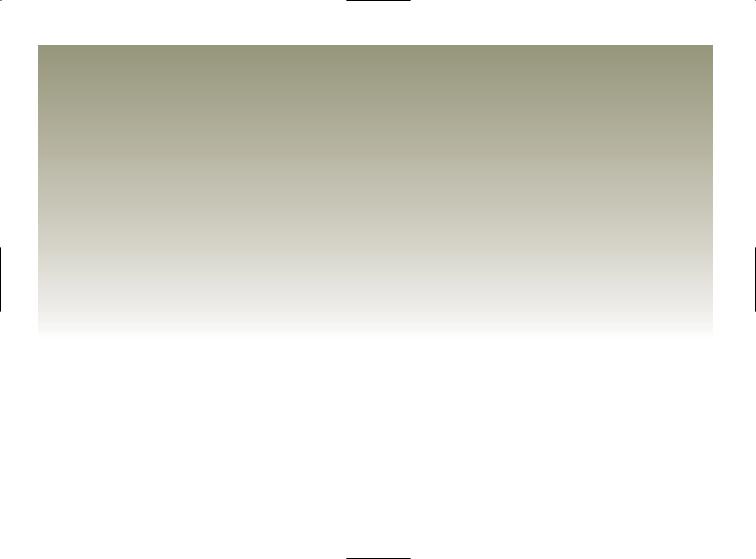
TYRE PRESSURES (in psi when cold)
Versions |
1.4 16V |
1.6 16V |
2.0 16V - 2.0 T |
||
|
|
|
|
|
|
Tyre sizes |
195/65 R15 T |
195/65 R15 H |
205/50 R17 V |
195/65 R15H |
205/50 R17 V |
|
205/55 R16 H |
205/55 R16 H |
|
205/55 R16 H |
|
|
205/55 R16 V |
205/55 R16 V |
|
205/55 R16 V |
|
|
205/50 R17 V |
|
|
|
|
|
|
|
|
|
|
Wheel sizes |
6.5 J 15 |
6.5 J 15 |
6.5 J 17 |
6.5 J 15 |
6.5 J 17 |
|
6.5 J 16 |
6.5 J 16 |
|
6.5 J 16 |
|
|
6.5 J 17 |
|
|
|
|
|
|
|
|
|
|
Non-motorway use |
|
|
|
|
33 |
• Front |
32 |
32 |
32 |
32 |
|
• Rear |
29 |
29 |
29 |
29 |
29 |
|
|
|
|
|
|
Motorway use (1) |
32 |
33 |
35 |
35 |
36 |
• Front |
|||||
• Rear |
29 |
29 |
29 |
29 |
29 |
|
|
|
|
|
|
Emergency spare wheel |
32 |
33 |
35 |
35 |
36 |
|
|
|
|
|
|
Tyre safety and use of snow chains
Refer to the paragraph on “Tyres” in Section 5 for information on maintenance and, depending on the version, the conditions under which chains may be fitted to the vehicle.
(1)Special note concerning vehicles used under full load (maximum permissible all-up weight) and towing a trailer.
The maximum speed must be limited to 60 mph (100 km/h) and the tyre pressure increased by 3 psi. Refer to the information on Weights in Section 6.
0.06

TYRE PRESSURES (in psi when cold) (continued)
Versions |
1.5 dCi |
1.9 dCi |
|
2.0 dCi |
|||
|
|
|
|
|
|
|
|
Tyre sizes |
195/65 R15 H |
205/50 R17 V |
195/65 R15 H |
205/50 R17 V |
205/55 R16 V |
205/50 R17 V |
|
|
205/55 R16 H |
|
205/55 R16 H |
|
|
|
|
|
205/55 R16 V |
|
205/55 R16 V |
|
|
|
|
|
|
|
|
|
|
|
|
Wheel sizes |
6.5 J 15 |
6.5 J 17 |
6.5 J 15 |
|
6.5 J 17 |
6.5 J 16 |
6.5 J 17 |
|
6.5 J 16 |
|
6.5 J 16 |
|
|
|
|
|
|
|
|
|
|
|
|
Non-motorway use |
32 |
32 |
32 |
|
33 |
35 |
38 |
• Front |
|
||||||
• Rear |
29 |
29 |
29 |
|
29 |
29 |
29 |
|
|
|
|
|
|
|
|
Motorway use (1) |
33 |
35 |
|
|
36 |
|
|
• Front |
35 |
|
38 |
40 |
|||
• Rear |
29 |
29 |
29 |
|
29 |
29 |
30 |
|
|
|
|
|
|
|
|
Emergency spare wheel |
33 |
35 |
35 |
|
36 |
38 |
40 |
|
|
|
|
|
|
|
|
Tyre safety and use of snow chains
Refer to the paragraph on “Tyres” in Section 5 for information on maintenance and, depending on the version, the conditions under which chains may be fitted to the vehicle.
(1)Special note concerning vehicles used under full load (maximum permissible all-up weight) and towing a trailer.
The maximum speed must be limited to 60 mph (100 km/h) and the tyre pressure increased by 3 psi. Refer to the information on Weights in Section 6.
0.07

0.08
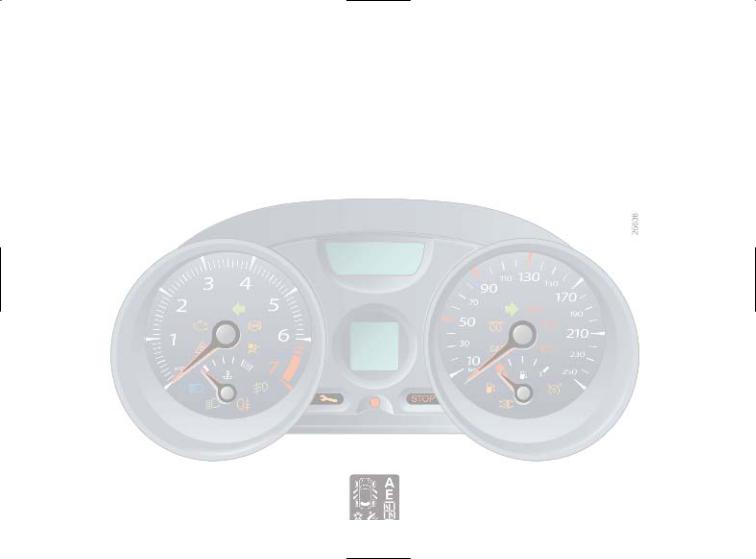
Section 1: Getting to know your vehicle
RENAULT Card: general information, use, deadlocking ............................................................................ |
1.02 1.08 |
|
Doors ...................................................................................................................................................................... |
1.09 1.13 |
|
Renault Anti-Intruder Device (RAID) ........................................................................................................................... |
1.14 |
|
Engine immobiliser ............................................................................................................................................... |
1.15 - 1.16 |
|
Headrests - Seats .................................................................................................................................................. |
1.17 1.20 |
|
Seat belts ............................................................................................................................................................... |
1.21 1.24 |
|
Additional restraint systems ............................................................................................................................. |
1.25 1.31 |
|
in addition to the front seat belts ............................................................................................................... |
1.25 1.28 |
|
in addition to the rear seat belts .............................................................................................................................. |
1.29 |
|
side protection device ................................................................................................................................................ |
1.30 |
|
Child safety ........................................................................................................................................................... |
1.32 1.42 |
|
Steering wheel ................................................................................................................................................................... |
1.43 |
|
Driver’s position .................................................................................................................................................. |
1.44 1.47 |
|
Instrument panel ................................................................................................................................................. |
1.48 1.77 |
|
Trip computer ................................................................................................................................................. |
1.66 1.77 |
|
Clock and exterior temperature ..................................................................................................................................... |
1.78 |
|
External rear-view mirrors ................................................................................................................................... |
1.79 - 1.80 |
|
Audible and visual signals ............................................................................................................................................. |
1.81 |
|
|
|
|
Lighting and exterior signals ............................................................................................................................ |
|
1.82 1.84 |
Headlight beam adjustment ............................................................................................................................................ |
|
1.85 |
Wipers/washers ................................................................................................................................................... |
|
1.86 1.88 |
Fuel tank (filling with fuel) ................................................................................................................................. |
|
1.89 - 1.90 |
1.01
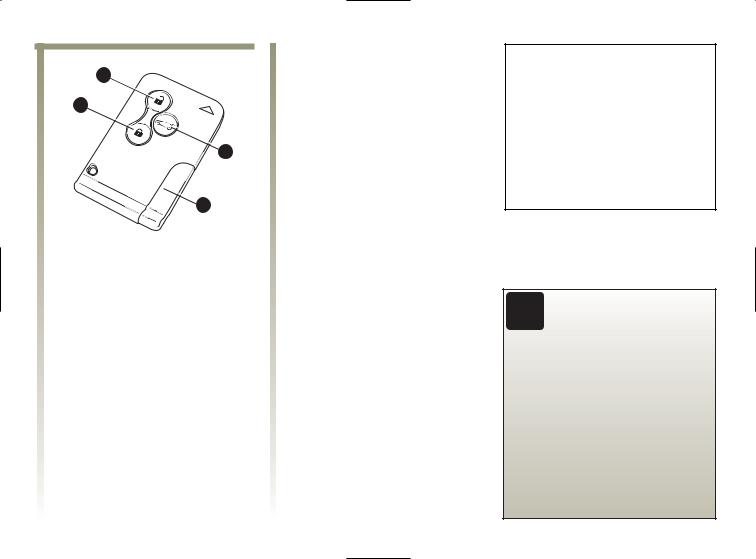
RENAULT CARDS: general information
1 |
24088 |
|
2
3
4
RENAULT card
1 - Unlocking the doors and luggage compartment.
2 - Locking all doors and luggage compartment.
3 - Locking/unlocking the luggage compartment.
4 - Integral emergency key.
The RENAULT card is used to:
-lock/unlock the doors and luggage compartment and the fuel filler flap (refer to the following pages);
-automatically close the electric windows and the sunroof; refer to the paragraphs on “windows with automatic opening” and “sunroof” in section 3 (depending on vehicle);
-start the engine; refer to the paragraph on “Starting the engine” in section 2.
Battery life
It is supplied by a battery which should be replaced when the message “Change card battery” appears on the instrument panel (refer to the paragraph on the “RENAULT card: battery” in section 5).
Range of the RENAULT card
This varies according to the environment. It is therefore important to make sure when handling the RENAULT card that you do not lock or unlock the doors by inadvertently pressing the buttons.
Advice
Do not keep your RENAULT card in a place where it could be damaged accidentally, such as in a back pocket where you might sit on it.
Driver’s responsibility
Never leave your vehicle with the RENAULT card inside and never leave a
child (or a pet) unsupervised. With the card in the reader, it would be possible to start the engine or operate electrical equipment such as the electric windows and there is a risk that they may trap part of their body (neck, arms, hands, etc.).
Risk of serious injury.
1.02
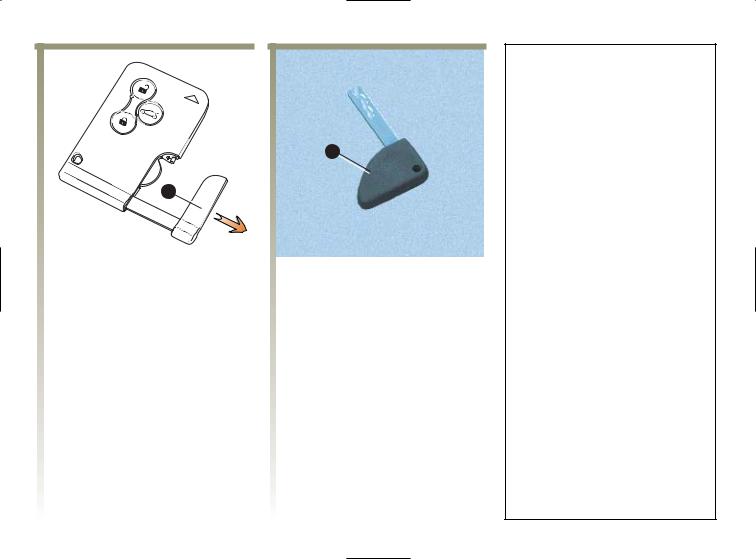
RENAULT CARDS: general information (continued)
24089
5 |
4
Integrated emergency key 4 or separate emergency key 5
(depending on the vehicle)
This is only used in exceptional circumstances. It locks or unlocks the left-hand side door if the RENAULT card does not work:
-if the vehicle is located in a zone of high electromagnetic radiation,
-if devices are being used with the same frequency as the card,
-drain on the RENAULT Card battery, flat battery, etc.
For instructions on how to use the emergency key, refer to the paragraph on “Locking and Unlocking the doors”.
Once you have entered the vehicle using the emergency key, insert the RENAULT card into the card reader in order to start the engine.
Replacement/need for an additional RENAULT Card
If you lose your RENAULT card or require another, you can obtain one from your RENAULT Dealer.
If a RENAULT card is replaced, it will be necessary to take the vehicle and all RENAULT cards to your RENAULT Dealer to initialise the system.
You can use up to four RENAULT cards per vehicle.
Faulty RENAULT card.
Always make sure the battery is in good condition; they have a service life of approximately two years.
See RENAULT card: batteries in Section 5.
1.03
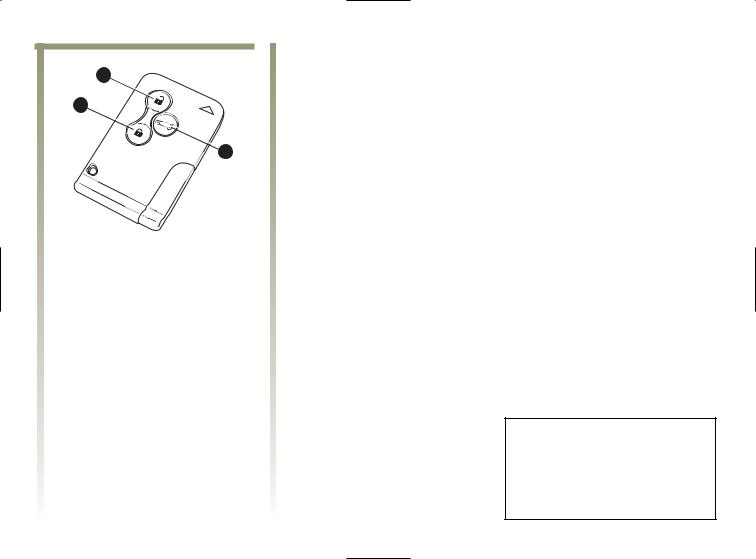
REMOTE CONTROL RENAULT CARD: use
1 |
24088 |
|
2
3
Unlocking the doors
Press unlocking button 1.
The hazard warning lights and side mounted indicators flash once to indicate unlocking.
Special notes (for some countries):
-pressing button 1 unlocks the driver’s door only,
-pressing button 1 twice in succession unlocks the other doors.
Locking the doors
Press locking button 2.
The side indicator lights and hazard warning lights flash twice to indicate that the doors have been locked:
-if a door or the luggage compartment is open or not properly shut, or if a RENAULT card is still in the reader, the doors and luggage compartment quickly lock then unlock and the hazard warning lights and side indicator lights do not flash.
Unlocking/locking the luggage compartment only
Press button 3 to unlock or lock the luggage compartment.
The hazard warning lights and side indicator lights flash once to indicate unlocking if the vehicle doors are locked.
The hazard warning lights and side indicator lights flash twice to indicate that the luggage compartment is locked if the vehicle doors are locked.
The card buttons are deactivated when the engine is running.
1.04
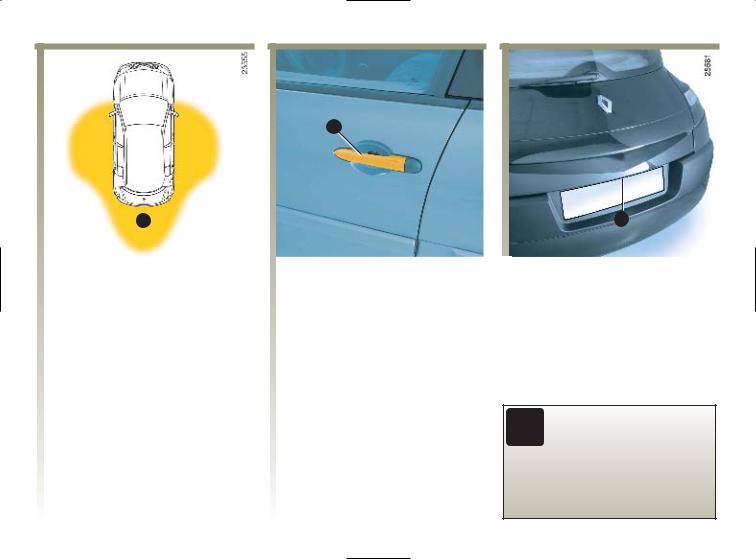
RENAULT CARD IN HANDS-FREE MODE: use
1
RENAULT card in hands-free mode
In addition to the RENAULT card remote functions, this enables the following to be carried out without touching the key card (in hands-free mode):
-unlocking/locking of the doors and boot and the fuel filler flap if the card is within access zone 1,
-and starting the engine if the card is present inside the vehicle passenger compartment (refer to the information on “Starting the engine” in section 2).
2
Unlocking the doors and luggage compartment
Walk up to your vehicle carrying your RENAULT card.
As soon as you place your hand behind the handle of a door 2, the vehicle will unlock.
When you press button 3, only the luggage compartment will unlock.
Unlocking is indicated by one flash of the hazard warning lights and the side indicator lights.
3
Never leave your vehicle with the RENAULT card inside.
1.05
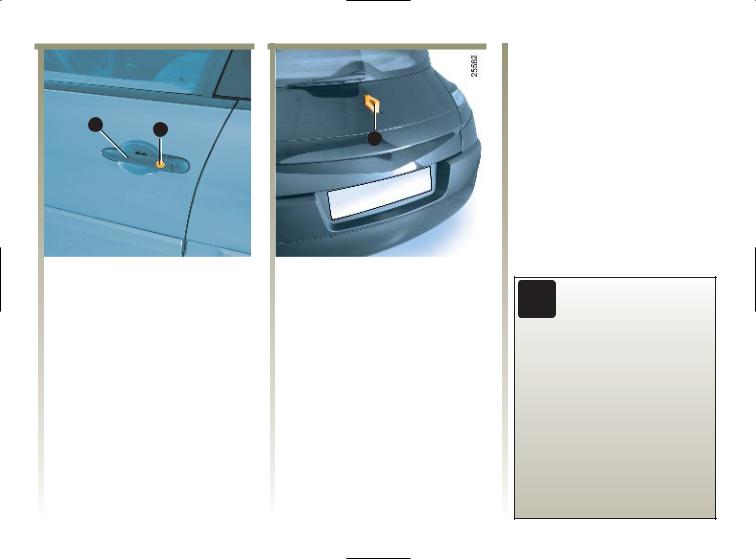
HANDS-FREE RENAULT CARD: use (continued)
If you wish to check that the doors are locked after locking with the RENAULT card or the buttons on the handles, you have approximately three seconds to try the door handles without unlocking them.
2 |
4 |
After this delay, the Hands-Free |
|
mode is activated once again and |
|
|
5 |
|
|
|
any movement of the handle will |
|
|
unlock the doors. |
Locking the doors and luggage compartment
Holding the RENAULT card and with the doors and luggage compartment closed, press button 4 located on one of the handles 2 or button 5 on the luggage compartment.
The side indicator lights and hazard warning lights flash twice to indicate that the doors have locked.
Note: the RENAULT card must be within the vehicle’s access zone for locking with the buttons to be possible.
If a door or the luggage compartment is open or not properly shut, or if a RENAULT card is present in the reader, the doors or luggage compartment lock then quickly unlock and the hazard warning lights and indicator lights do not flash.
Driver’s responsibility
Never leave your vehicle with the RENAULT card inside and never leave a
child (or a pet) unsupervised.
There is a risk that they could start the engine or operate electrical equipment (electric windows) and trap part of their body (neck, arms, hands, etc.). Risk of serious injury.
1.06

DEADLOCKING
24088
1
Deadlocking the doors/luggage compartment (for some countries)
This allows you to lock the opening elements (doors, luggage compartment and, depending on vehicle, the passenger side storage compartment) and to prevent the doors from being unlocked using the interior handles (for example, by breaking the window and then trying to open the door from the inside).
To activate deadlocking
Vehicles equipped with rear door electric windows
-press button 1 twice in quick succession.
-or press the exterior door handle buttons or the luggage compartment badge twice in quick succession.
Vehicles equipped with rear door manual windows
Before exiting the vehicle, press the lower section of switch 2 (the integrated indicator lights up). Press the upper section of the switch to unlock the doors.
In all situations
The hazard warning lights flash five times to indicate locking.
Note: it is possible to activate this function by two simultaneous presses on the door handle buttons located on the same side (for example: front left/rear left or front right/rear right).
2
Never use deadlocking if someone is still inside the vehicle.
1.07
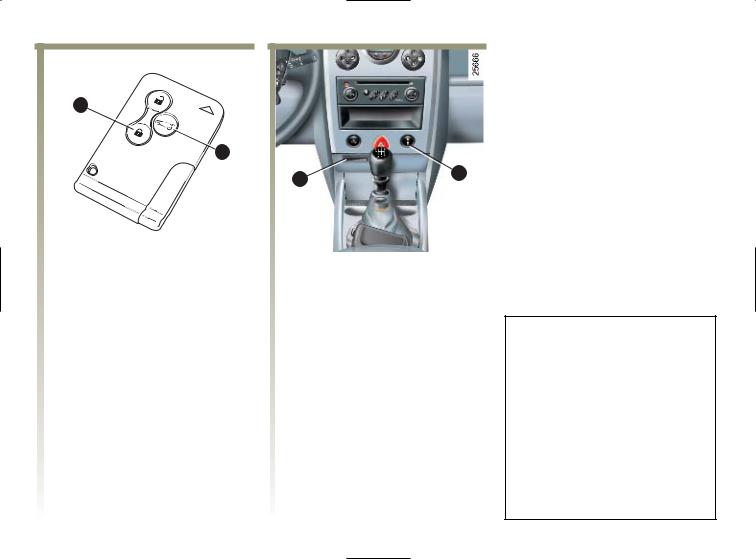
RENAULT CARD IN RESTRICTED MODE
24088
1
2
3 |
4 |
|
RENAULT card restricted use
(depending on vehicle)
In certain situations (when the vehicle is in the hands of a third person: valet parking, repair agent, etc.) you may wish to restrict the operation of the RENAULT card.
Obtain two cards. Insert one card in card reader 3 then press buttons 1 and 2 on the second card at the same time. The vehicle will be locked then the driver’s door will be unlocked.
The RENAULT card inserted in the card reader switches to restricted mode.
The RENAULT card in restricted mode will only unlock the driver’s door and the fuel filler flap and start the engine (the passenger storage compartment and the luggage compartment remain locked).
To cancel restricted mode, start the vehicle with the RENAULT card in non-restricted mode.
The door lock/unlocking control from the inside 4 is deactivated when the vehicle is used with the RENAULT card in the restricted use mode.
It is only possible to restrict the use of one RENAULT card at a time.
When using a RENAULT card in the restricted use mode, the second card retains all of its functions.
1.08
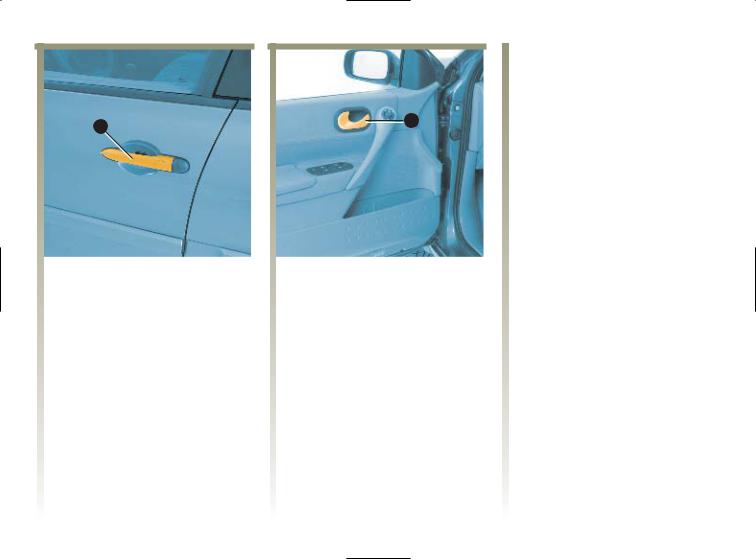
OPENING AND CLOSING THE DOORS
1 |
2 |
|
Opening the doors from the outside
Once the doors have been unlocked or you have the hands-free RENAULT card on you, hold handle 1 and pull it towards you to open the door.
Opening the doors from the inside
Pull handle 2.
Lights on warning buzzer
If you have switched off the ignition and left the lights switched on a reminder buzzer will sound when a door is opened.
Card reminder buzzer
A beep will let you know if you have left the card in the reader when you open the driver’s door, and the “remove card” message will appear on the instrument panel.
Special note
After switching off the engine, the lights and any accessories that are in operation (radio, air conditioning, etc.) will continue to operate.
They will stop as soon as the driver’s door is opened.
Door/luggage compartment open buzzer
If a door (or luggage compartment) is open or not properly closed, as soon as the vehicle reaches a speed of approximately 6 mph (10 km/h), the message “luggage compartment open” or “door open” (depending on what is open) will appear on the instrument panel accompanied by a warning light.
1.09
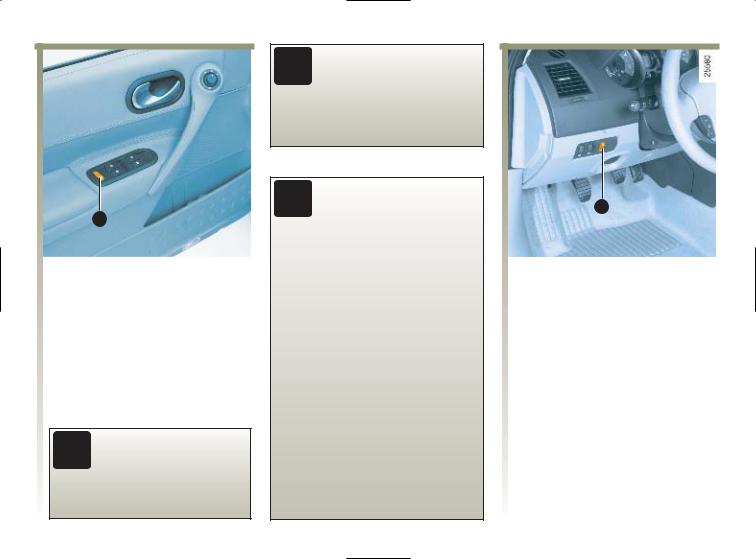
OPENING AND CLOSING THE DOORS (continued)
3
Child safety
Vehicles fitted with switch 3 with integrated indicator light
Press switch 3 to prevent the operation of the rear electric windows and opening of the rear doors.
The indicator light in the switch lights up to confirm that the doors are locked.
If there is a fault, you will hear a beep and the integrated indicator will not light up.
Rear door central locking must be reactivated following disconnection of the battery by pressing switch 3.
Safety of rear occupants
 The driver can inhibit operation of the rear electric windows and doors by pressing switch 3 on the side with
The driver can inhibit operation of the rear electric windows and doors by pressing switch 3 on the side with
the symbol.
Driver’s responsibility
Never leave your vehicle without removing the RENAULT card from inside and never leave a child (or a pet) inside. With the key in the ignition it would be possible to operate the electric windows and there is a risk that a child or animal may be seriously injured (by trapping his or her neck, arm, hand, etc.). If something gets trapped, reverse the direction of travel as soon as possible by pressing the relevant switch.
4
Other cases
To make it impossible for the rear doors to be opened from the inside, press switch 4 and check from the inside that the doors are securely locked.
1.10
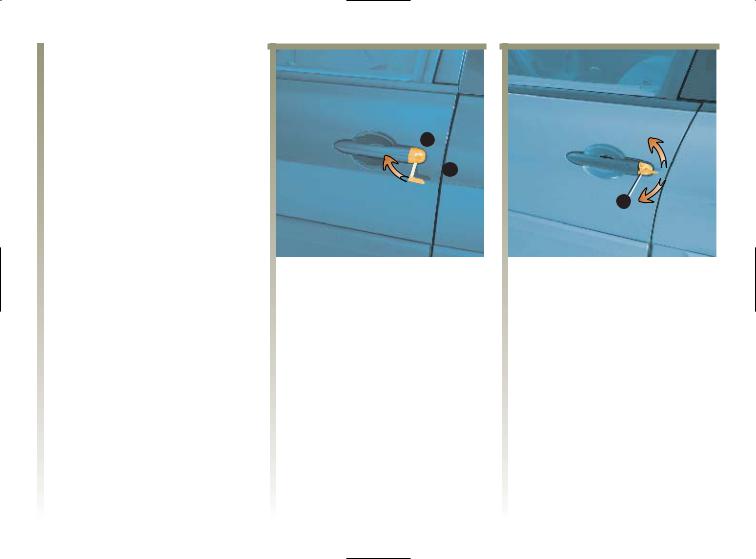
LOCKING/UNLOCKING THE DOORS
Locking/unlocking the doors from the outside
This is done using the RENAULT card; see RENAULT card in Section 1.
In certain cases, the RENAULT card may not work:
-if the vehicle is located in a zone of high electromagnetic radiation,
-if appliances operating on the same frequency as the card (mobile phone, etc.) are used;
-drain on the RENAULT Card battery, flat battery, etc.
It is then possible:
-to use the emergency key (depending on vehicle, either built into the card or separate) for the front left-hand door;
-to manually lock each of the doors (see the following page);
-to use the door locking and unlocking control inside the vehicle (refer to the information on Locking and unlocking from the inside in Section 1).
A
 1
1
2
Using emergency key 2 built into the RENAULT card
Remove cover A from the front lefthand door (using the tip of the emergency key) in notch 1.
Move it upwards to remove cover A.
Insert key 2 into the lock of the front left-hand door and lock or unlock.
1.11
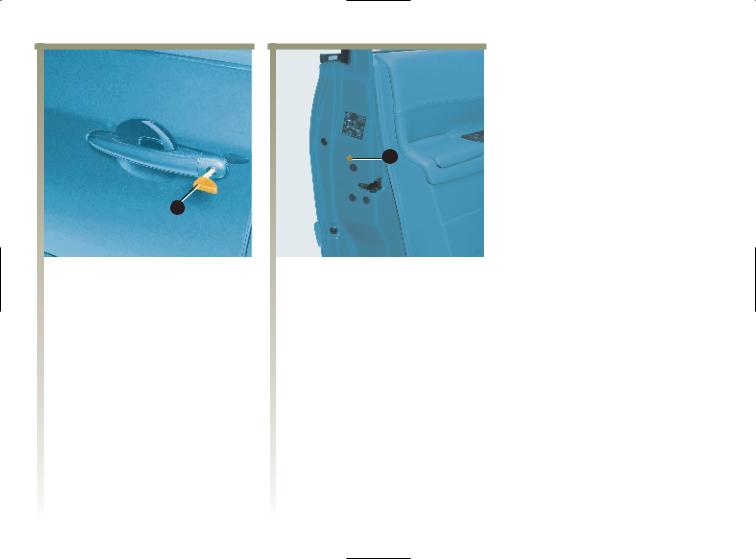
LOCKING/UNLOCKING THE DOORS (continued)
4
3
Using the separate emergency key 3 (depending on vehicle)
Insert key 3 into the lock of the lefthand door and lock or unlock the door.
Locking the doors manually
With the door open, rotate bolt 4 (using a flat-blade screwdriver or similar) and close the door.
This means that the doors are then locked from the outside.
The doors may then only be opened from the inside or by using the key in the front left-hand door.
1.12
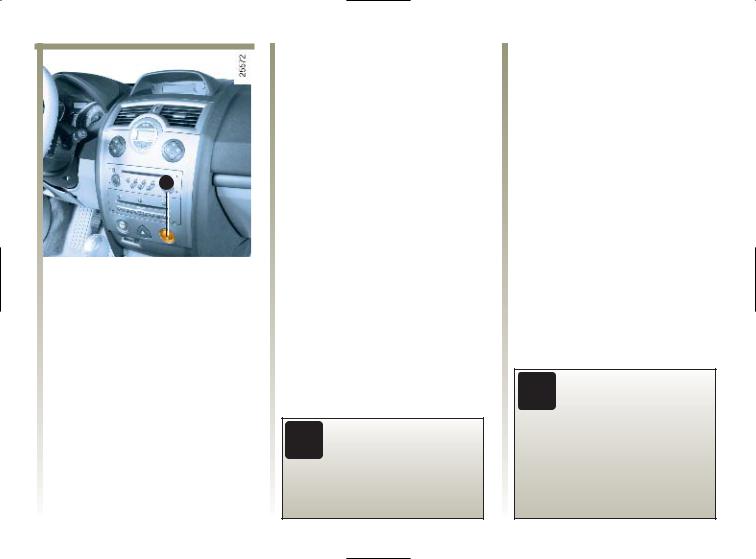
LOCKING/UNLOCKING THE DOORS (continued)
5
Control for locking and unlocking from the inside
Switch 5 controls the doors, the luggage compartment and the fuel filler flap at the same time and, depending on the vehicle, the passenger storage compartment.
If a door or the luggage compartment is open or not closed properly, the doors and luggage compartment lock/unlock quickly.
If transporting an object with an opening element (door or the luggage compartment) open: with the engine stopped, press switch 5 for more than five seconds to lock the other opening elements.
Locking the doors and luggage compartment without the RENAULT card
With the engine switched off and a front door open, press and hold down switch 5 for at least five seconds.
When the door is closed, all the doors and luggage compartment will be locked.
Unlocking the vehicle from the outside will only be possible with the RENAULT card.
Never leave your vehicle with the RENAULT card inside.
Doors and luggage compartment status indicator
When the ignition is switched on, the indicator light integrated in the switch informs you of the door locking status:
-light on, the doors and boot are locked,
-light not on, the doors and luggage compartment are unlocked.
When you lock the doors, the indicator light remains lit for approximately one minute then goes out.
If you decide to keep the doors locked when you are driving, remember that it may be more difficult for
those assisting you to gain access to the passenger compartment in the event of an emergency.
1.13
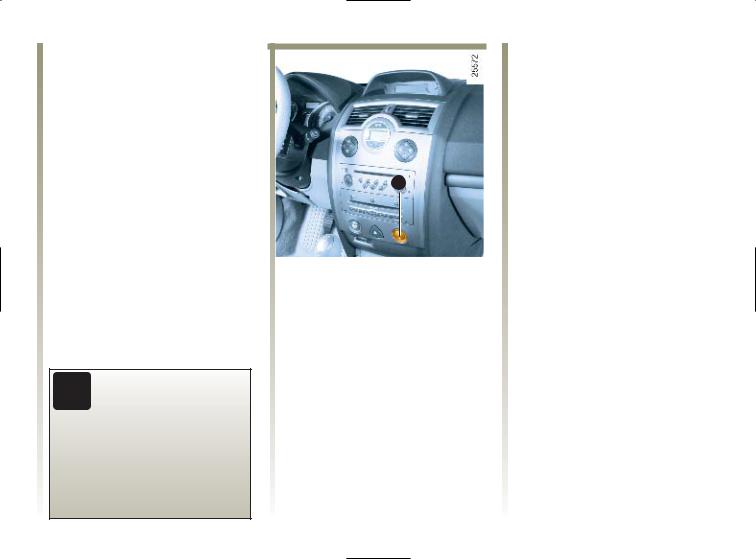
RENAULT ANTI-INTRUDER DEVICE (RAID)
You must first decide if you want to activate this function.
To activate
With the ignition on, press central door locking button 1 for approximately 5 seconds, until you hear an audible message.
To deactivate
With the ignition on, press central door locking button 1 for approximately 5 seconds, until you hear an audible message.
If you decide to keep the doors locked when you are driving, remember that it may be more
difficult for those assisting you to gain access to your vehicle in the event of an emergency.
1
Operating principle
When the vehicle is started, the system automatically locks the doors when you are driving at about 6 mph (10 km/h) and over.
The door can be unlocked:
-by pressing door unlocking button 1.
-when stationary, by opening a front door.
Note: if a door is opened, it will lock again automatically when the vehicle reaches a speed of approximately 6 mph (10 km/h).
Operating faults
If you notice an operating fault (no automatic locking, the indicator light integrated in button 1 does not come on when locking the doors and luggage compartment, etc.), first check that the doors and luggage compartment are properly closed. If they are closed correctly, consult your RENAULT Dealer.
1.14
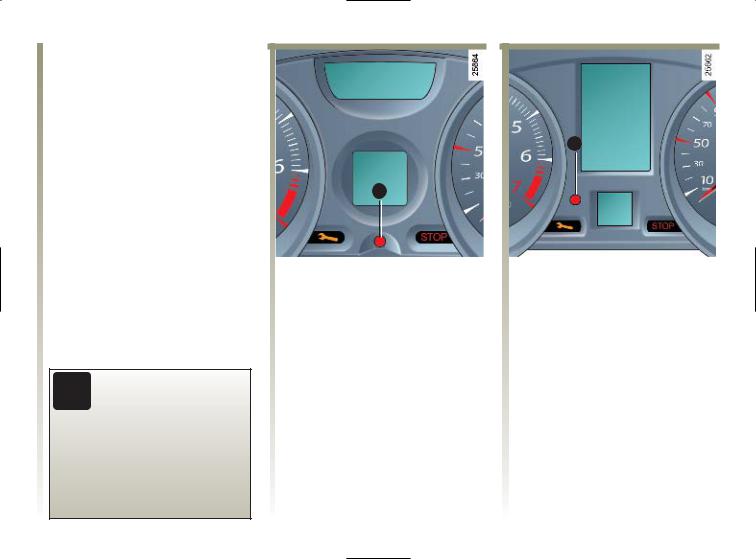
ENGINE IMMOBILISER
This prevents the vehicle being driven by anyone not in possession of the vehicle’s RENAULT card.
The vehicle is automatically protected a few seconds after the engine is switched off.
Any work or modification to the engine immobiliser (electronic units, wiring, etc.) may be dangerous. It
must be carried out by a qualified RENAULT technician.
1
1
Operating principle
When the engine is started, warning light 1 remains on for a few seconds and then goes out (refer to the information on starting the engine in Section 2).
If the code is not recognised, the card reader flashes rapidly and the vehicle cannot be started.
Indicator lights
Vehicle protection indicator light
After the ignition has been switched off, indicator light 1 will flash and the vehicle is protected.
1.15
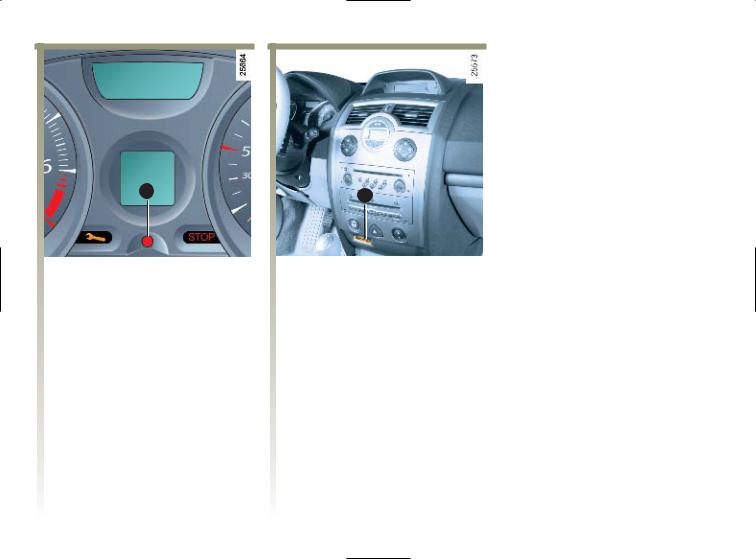
ENGINE IMMOBILISER (continued)
1 |
2 |
|
Operating fault warning light
After attempting to start the engine, if the warning light continues to flash or remains on continuously, this indicates that there is a system operating fault.
If the RENAULT card is faulty (card reader flashing rapidly), if possible use the second RENAULT card (supplied with the vehicle).
In this situation, it is essential to contact a RENAULT Dealer who is the only one qualified to repair the engine immobiliser system.
If there is interference and/or the hands-free RENAULT card is not recognised, insert it into the card reader 2.
1.16
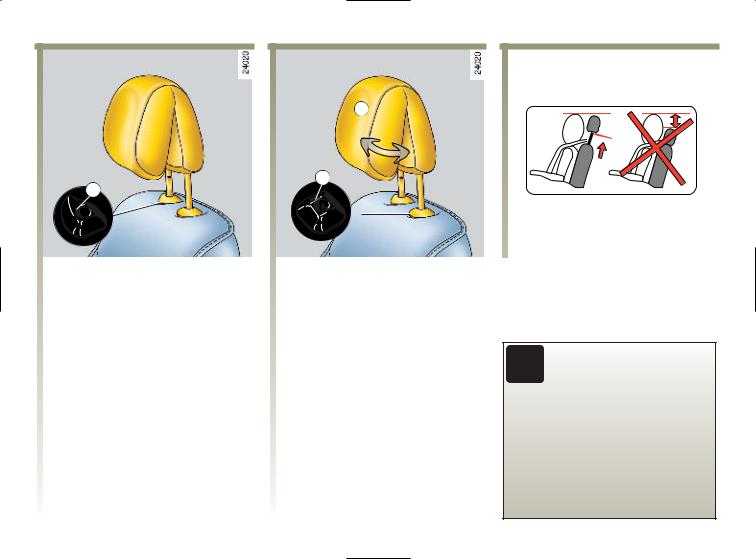
FRONT HEAD RESTRAINTS
A
2
1
Head restraints with a tab 1:
To adjust the headrest
Slide it upwards to the required height.
To lower the headrest
Move tab 1 forwards and lower the head restraint to the required height.
To adjust the angle of the headrest
Depending on the vehicle, move section A of the headrest forwards or backwards until it feels comfortable.
To remove the head restraint
Press button 2 and lift the head restraint until it comes free.
To refit the head restraint
Insert the head restraint rods into the holes, with the notches facing forwards.
Move tab 1 forwards and lower the head restraint to the required height.
The head restraint is  important for safety. Ensure that it is in place and in the correct position. The distance between your head and the head restraint should be as small as possible. The top of your head should be in line with the top
important for safety. Ensure that it is in place and in the correct position. The distance between your head and the head restraint should be as small as possible. The top of your head should be in line with the top
of the head restraint.
1.17
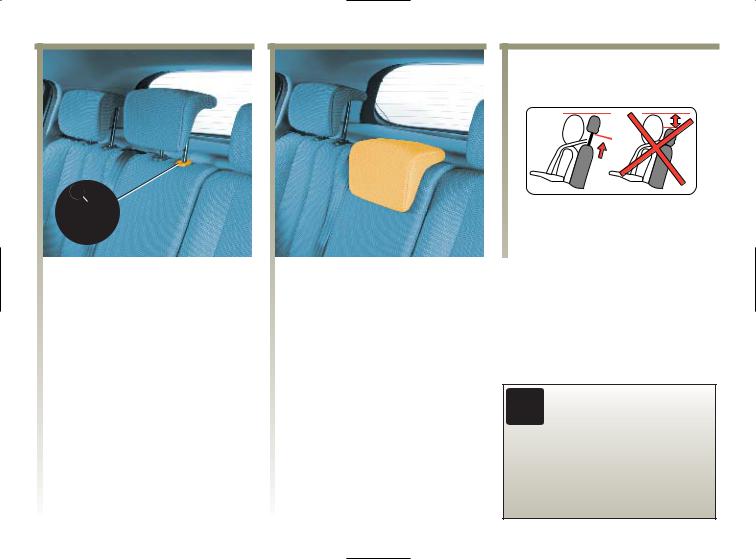
REAR HEAD RESTRAINTS
1 |
Position for use
Fit the head restraint as far as it will go, then, while keeping the head restraint pulled towards you, lower it until it locks into place.
The head restraint does not lower fully. To do this, press tab 1 and push the head restraint simultaneously.
To remove it
Press tab 1 and then remove the head restraint completely.
To refit the head restraint
Insert the rods into the holes, press tab 1 and lower the head restraint.
Storage position
Press tab 1 and lower the head restraint completely.
When the headrest is set at the lowest position, this is for storage only. It must not be used in this position when a seat is occupied.
The head restraint is a safety component, check that it is fitted and in the correct position.
1.18
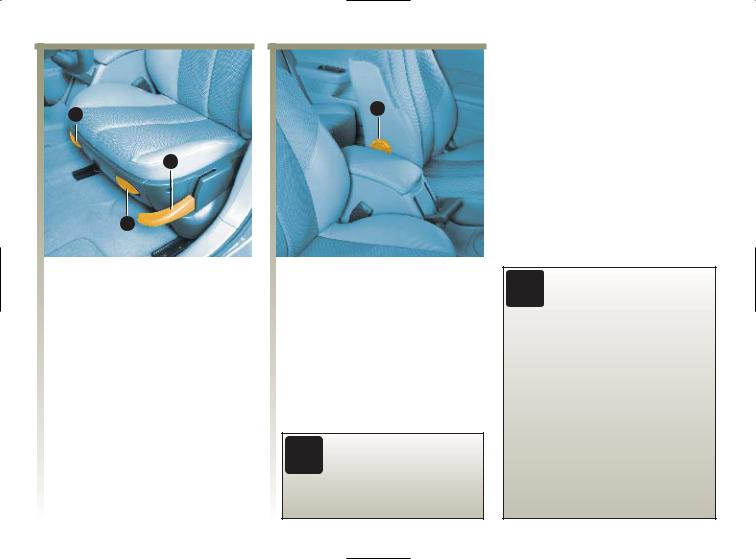
FRONT SEATS
1
2
3
To move a seat forwards or backwards
Lift handle 3 on the door side to unlock the seat. Release the handle in the desired position and check that the seat has locked in place properly.
To tilt the seatback
Lift the handle on the centre console side 1 and tilt the seatback until it is in the required position.
To adjust the driver’s seat height:
Move lever 2 as many times as necessary:
-upwards to raise the seat base,
-downwards to lower the seat base.
4
To adjust the lumbar support on the driver’s seat
Adjust control knob 4.
For safety reasons, make these adjustments only when the vehicle is stationary.
To avoid hindering the efficient operation of the seat belts, you are advised to keep the seat belt on your
shoulder.
Make sure that the seatback is locked in place correctly.
No objects should be placed on the floor (area in front of driver) as these objects could slide under the pedal during braking manoeuvres, thus obstructing its use.
1.19
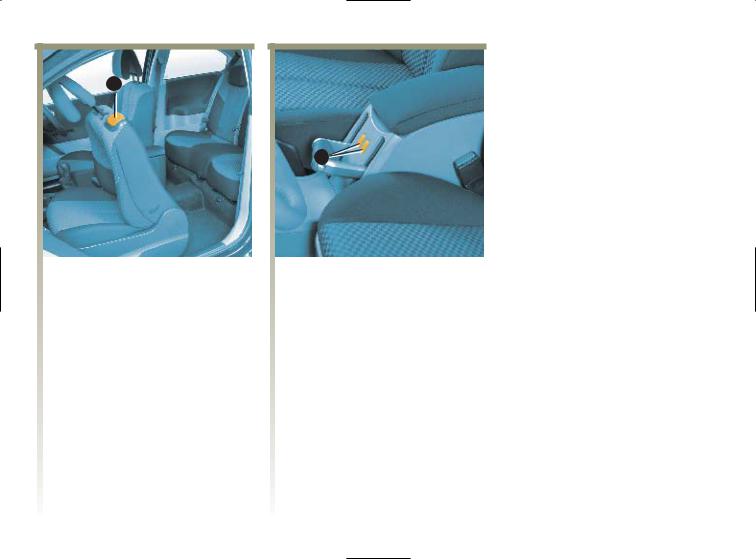
FRONT SEATS (continued)
5
6 |
Access to the seat bases
(three-door versions)
Lift handle 5 and slide the seat forwards.
To return the seat to its initial position (stored position) on the driver’s side, slide the seat backwards until it locks into place.
Heated seats
With the ignition switched on, move switch 6 of the required seat. The indicator light in the switch lights up.
The system, which has a thermostat, decides whether or not the heating is needed.
1.20
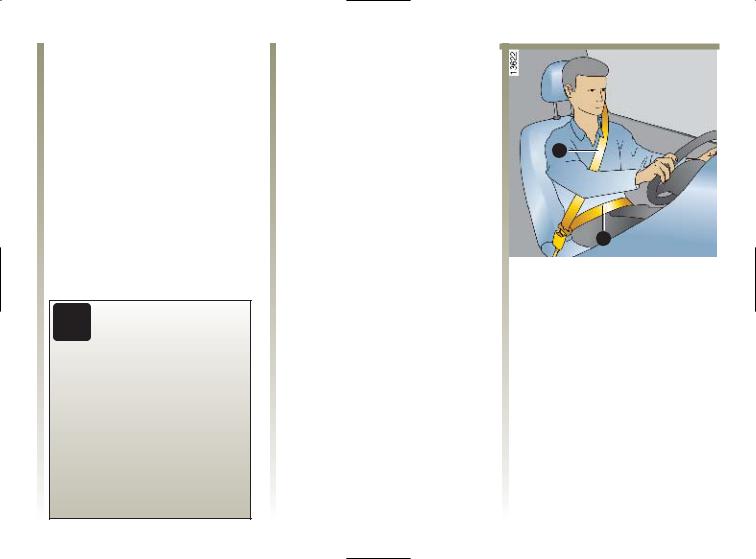
SEAT BELTS
Always wear your seat belt when travelling in your vehicle. You must also comply with the legislation of the particular country you are in.
Before driving off:
-firstly ensure that your driving position is correctly adjusted,
-then adjust your seat belt to provide maximum protection.
Incorrectly adjusted seat belts may cause injuries in
the event of an accident.
Even pregnant women should wear a seat belt. In this case, ensure that the lap belt is not exerting too much pressure on the abdomen without allowing any slack.
Adjusting your driving position
•Sit well back in your seat (having removed your coat or jacket). This is essential to ensure your back is positioned correctly.
•Adjust the distance between the seat and the pedals. Your seat should be as far back as possible while still allowing you to fully depress the clutch pedal. The seatback should be adjusted so that your arms are slightly bent when you hold the steering wheel.
•Adjust the position of your head restraint. For safety reasons, the top of your head should be in line with the top of the head restraint.
•Adjust the height of the seat. This adjustment allows you to select the seat position which offers you the best possible view.
•Adjust the position of the steering wheel.
1
2
Adjusting the seat belts
Sit with your back firmly against the seatback.
The thorax belt 1 should be as close to the base of your neck as possible but not on it.
The lap belt 2 should be worn flat over your thighs and against your pelvis.
The belt should be worn so that it is as close to your body as possible, i.e. avoid wearing heavy clothing or keeping bulky objects under the belts.
1.21
